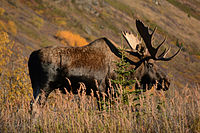
Photo from wikipedia
Populations within ecological communities constantly fluctuate due to a multitude of interactions that can be influenced by climate change. Moose (Alces alces (Linnaeus, 1758)) populations in northern New Hampshire and… Click to show full abstract
Populations within ecological communities constantly fluctuate due to a multitude of interactions that can be influenced by climate change. Moose (Alces alces (Linnaeus, 1758)) populations in northern New Hampshire and western Maine, subunits of the largest regional moose population in the continental United States, are suspected to be declining due to increasing frequency of winter tick (Dermacentor albipictus Packard, 1869) epizootics that cause >50% late-winter mortality of 9- to 12-month-old calves. To investigate this hypothesis, we collected general health measurements of calves captured at two study sites in January 2014–2016 and subsequently performed field necropsies and histologic examination of tissues of those radio-marked calves that died during winter and spring. At capture, calves (n = 179) were in normal (66%) and thin (32%) physical condition with high infestations of winter ticks. Most (88%) mortalities (n = 125) were associated with moderate to severe infestations of winter ticks. Gross necropsies and histologic examination found high tick infestations, emaciation, anemia, and endoparasitism; lungworm (species of the genus Dictyocaulus Railliet and Henry, 1907) was also found in most (87%) calves. Three consecutive years (2014–2016) of winter tick epizootics is unprecedented in the region, rare in North America, and arguably reflects a host–parasite relationship strongly influenced by climate change at the southern fringe of moose habitat.
Journal Title: Canadian Journal of Zoology
Year Published: 2019
Link to full text (if available)
Share on Social Media: Sign Up to like & get
recommendations!